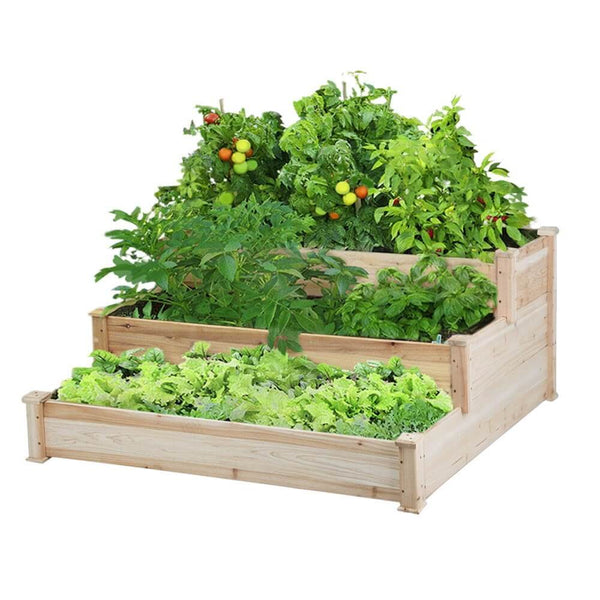Enjoy 5% Off Site Wide
Enjoy 5% Off Site Wide

Wonderful news! With May approaching, you can begin seeding a range of vegetables such as carrots, radishes, beans, cabbage, beets, and herbs as soon as the soil temperature is warm enough.
To assist you in selecting the best raised garden bed, we have compared the main pros and cons of metal and wood raised garden beds in this article.
Using a raised garden bed has so many benefits, it's hard to list them all! For starters, it's the perfect solution for gardeners who want to protect their plants from problematic soils.
Whether you're dealing with rock, clay or uncertain backyard soils, a raised garden bed is your most effective and affordable option.
Plus, the elevated design means healthier growing conditions for your crops all year-round. You'll be amazed at how well your vegetables and herbs thrive in this environment!
Best of all, a raised garden bed can look beautiful too, making your garden the perfect place to entertain friends and family.
And let's not forget about the convenience factor – the most popular height for raised beds is 11 inches, which means less bending and less stress on your back and knees.
While there are certain disadvantages to planting in raised beds:
Spend extra money and effort building or purchasing a raised garden bed
Some vegetables or fruits, such as watermelon and sweet corn, cannot grow in a compact raised bed
There is concern about chemicals leaching from the material used to make the raised bed

When it comes to raised bed materials, wood is a global building material that is possibly the most popular among gardeners. Wood is widely available, generally at reasonable prices, and can be used for up to 10 years before needing to be replaced.
Cedar and redwood are especially resistant to dampness, rot, and termites. Hardwoods such as beech, oak, and walnut are strong and less likely to crack over time. If cost is a consideration, fir, pine, and spruce garden beds are good choices.
The thickness of your wood planks also has an impact on the lifespan of your garden bed. Garden beds made of 2" thick boards will last longer than beds made of 1" thick boards.
Wood raised garden beds are ideal for creating a more natural and rustic garden. Unpainted wood beds usually have distinct wood grain and knots that contrast with the lush green plants for added aesthetic flair.
Metal garden beds are more difficult to find than wood garden beds. If you go to a local big box shop or lumber yard, you can discover a range of wood that is perfect for building a garden box on your own. Online shopping platforms also offer a large selection of inexpensive, easy-to-assemble wooden garden beds.
Best of all, wooden raised garden beds give you more options than metal raised garden beds, which are built to match your individual demands or adapt to a small space.




Metal elevated beds have grown in favor among gardeners in recent years. Although more expensive than wood alternatives, galvanized steel beds offer easy assembly, resistance to rust and corrosion, and exceptional longevity with minimal upkeep.
The primary benefit of using metal garden beds is their higher corrosion resistance, making them a sturdy and long-lasting option. This type of metal is typically made of galvanized steel, which has a protective covering of zinc that prevents rusting in wet environments.
Metal planters are an excellent choice for gardening enthusiasts who live in areas with long wet seasons. Unlike wooden beds, these planters are not impacted by humidity or rainfall-no more worries about replacing your garden beds over time.
Galvanized steel planters are undoubtedly durable and resistant to wear and tear when compared to raised wooden beds made of thinner boards. They have great endurance and strength, and can withstand the load of heavy, moist soil for years without bowing or cracking.
Metal vegetable beds are popular due to their ease of installation and low maintenance requirements. They require simply nuts and bolts to assemble and can be readily cleaned with a moist cloth.
Galvanized garden beds are not only functional, but they also lend an industrial and trendy touch to any backyard or garden. They come in a variety of hues and can easily complement your home's décor.
Galvanized planters always have an open-ended base, which keep plants from becoming saturated with water, which can kill them. Furthermore, by linking the dirt under the bed with the soil you add to the bed, this design allows the roots to better absorb the nutrition.
Wooden raised garden beds are ideal for beginning gardeners since they are easy to find, less expensive, and come in a variety of styles. However, if you’re a seasoned gardener and love to grow veggies or other plants in your backyard, you might consider upgrading to a metal garden bed. With a longer lifespan and less upkeep needed, it’s a wise investment you won’t regret.
Leave a comment